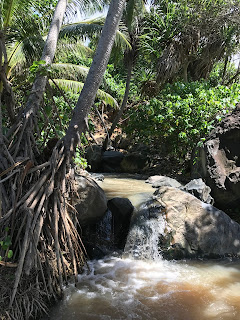Jerome picked us up at 08:00, and we left Emily to go spear fishing with journalist, Alina, on their paddle boards. We collected three Tahitians from the Pension and set off towards Ho Hoi. The other passengers were a young couple who work in air traffic control, and a lady who tours the islands giving careers advice.
Jerome's Toyota 4x4 was worked hard during the day, as the concrete road would periodically turn into a rough slippery track, badly eroded by torrential rain. He explained that this was because the island was all privately owned in radial strips from mountain to sea. If the owner, or more usually entire family, did not agree then the government could not improve the road. He said it was a sign of the intelligence of each family if they had improved the road, as we struggled through some sections and then had easy going on the improved bits.
 |
| HoHoi Bay |
Down in HoHoi we met a sculptor of the unique
Pierre Fleuri stone. Th stone i coloured a bit like tiger's eye and has lovely crystals like stone flowers in it which are lovey when ground to a shine. Justin said the sculptor looked familiar, and we soon established that we had met his neighbour and cousin, Simon, working stone in the same style in Fatu Hiva. He gave us a demonstration of his technique, and we had the chance to buy some nice small stone tikis in this unique stone. At 27,000 CFP (£197) each it was more than we felt like spending, but we were given some bits of stone and I gave him a London double decker bus key ring as a souvenir of a British visit.
 |
| Stone carving workshop at HoHoi |
 |
| Streams rushing down to the beach |
 |
| The sculptor's father was the model for the portrait on this 500 CFP note (£3.70) |
 |
| New Caledonia shown on the reverse of the 500 CFP note |
 |
| Jerome shows where pigment was ground for tattooing |
 |
| Anne at the Marae |
We got down to the beach where the special
Pierre Fleuri stones get rolled down by the river, but failed to find one. The mozzies found me though, whilst I tried to sketch the scene! Finally we visited an archeological site, of a
Marae or sacred Chiefs court, getting a really good idea of how it was used, and seeing the well worn stones where adzes were sharpened and where tattooing ink was prepared. A relic of an extraordinary complex society, tuned to its environment, but overturned by foreigners bringing new ways and new diseases. The Marquesans were in danger of extinction but "saved" by foreign settlers who were encouraged to marry in, so that one can see O'Connors and many other European and Asian family names nowadays.
Back in town everyone was voting as today was the first round of the French presidential election. We got aboard and raised anchor and sail and set off the 25 miles north to Nuku Hiva, getting there at sundown.







No comments:
Post a Comment